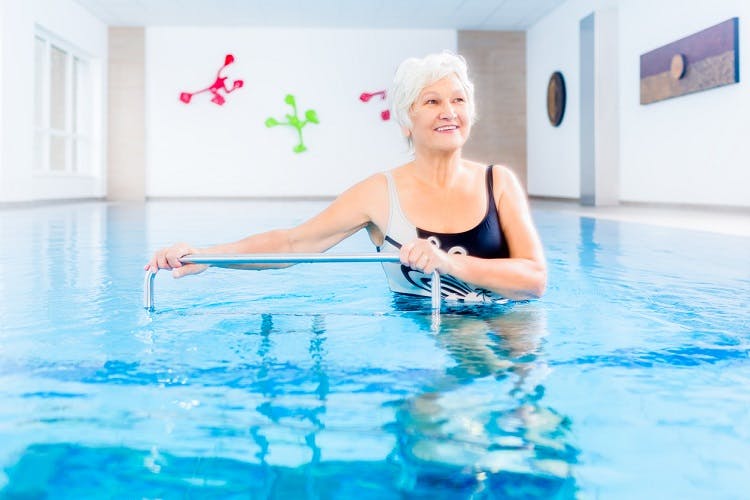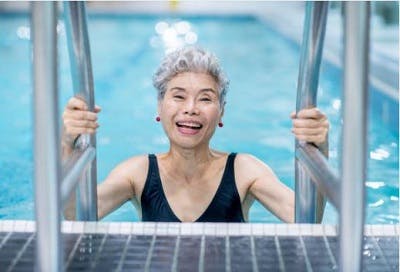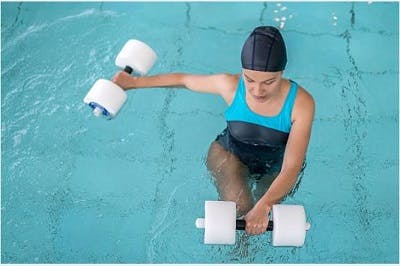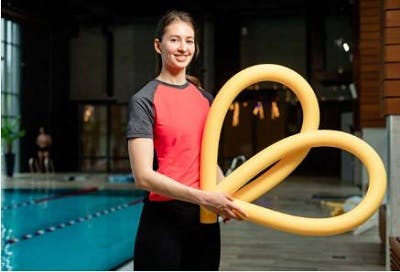No products in the cart.
No products in the cart.
No products in the cart.
No products in the cart.
Home » Neurological Recovery Blog » Spinal Cord Injury » Aquatic Therapy for Spinal Cord Injury: Promoting Recovery with Pool Exercises
Last updated on June 8, 2022

Aquatic therapy for spinal cord injury rehabilitation is an effective way to develop balance, strength, and movement patterns. Aquatic therapy is a safe and often very engaging form of physical therapy for survivors when supervised by a trained physical therapist.
A physical therapist can provide various pool exercises for spinal cord injury suited to your ability level that can help boost recovery. Compared with land-based physical therapy, aquatic therapy exercises put less stress on the joints. This makes it easier to move, which many spinal cord injury survivors love.
Aquatic therapy pools are typically heated, and may be located indoors or outdoors. This change of scenery is another reason why many survivors find aquatic therapy fun and motivating.
This article will discuss popular pool exercises for spinal cord injury that you can try with a trained caregiver or therapist. Feel free to use the links below to jump straight to any section of this article.
First, let’s take a look at the additional benefits and the risks of engaging in aquatic therapy after sustaining a spinal cord injury.

Every spinal cord injury is different and every survivor may experience different secondary effects depending on the severity and level of injury. The main secondary effects of spinal cord injury are changes in or loss of motor and sensory functions.
A common secondary effect of spinal cord injury on the muscles is spasticity, or involuntary muscle contractions. Spasticity affects around three out of four spinal cord injury survivors, and is caused by disrupted signals between the brain and areas below the level of injury.
Spasticity is triggered by movement and is also velocity-dependent. This means the quicker a muscle is stretched, the more severe the contraction, which can lead to stiff movements and jerky spasms.
Fortunately, research shows that aquatic therapy can help reduce the effects of spasticity after spinal cord injury. Studies also found that pool exercises after spinal cord injury can help improve body composition, strength in the muscles, and reduce pain.
Water holds several inherent benefits that help promote mobility after spinal cord injury. These properties include buoyancy (allowing you to float), viscosity (resistance to movement), and hydrostatic pressure (water pressure on the body).
Due to these characteristics of water, there are several benefits specific to aquatic therapy for spinal cord injury survivors:
After a spinal cord injury, survivors may experience muscle atrophy, which refers to the shrinking of muscles. This primarily occurs due to lack of mobility and use of the muscles, which can be challenging especially for survivors with paraplegia or quadriplegia. Fortunately, the benefits of buoyancy can help reverse muscle atrophy, and encourage mobility.
Buoyancy is the way a body can float or rise when submerged in water. It’s what makes you feel light in the water and helps keep you afloat. Buoyancy is effective because it helps relieve pressure from your joints. With less weight to bear, it becomes easier for spinal cord injury survivors to focus on movement, balance, and proper gait (walking) patterns. Furthermore, a fear of falling is much less prominent during aquatic therapy, since survivors are unlikely to get injured if they lose their balance.
Spinal cord injury survivors can increase the difficulty level of their exercises by moving into shallower water. Over time, and with consistent practice, this will help accustom the joints to bearing more weight.
Water can also help promote recovery after spinal cord injury through drag force and viscosity. Drag force is the resistance of a fluid against an object in motion, whereas viscosity refers to the resistance of a fluid at a given rate.
When it comes to a body of water like a pool, viscosity is what adds resistance and makes it challenging to move at a fast pace. However, this is actually beneficial during spinal cord injury recovery because it helps strengthen the muscles. Viscosity can also help improve joint flexibility and reduce stiffness in the knees and other joints.
Additionally, the resistance of water is greater than air, which is why movement with the same amount of energy is slowed down in water. In order to maintain normal speed underwater, the muscles must exert more effort, which develops strength.
Lack of movement due to a spinal cord injury can often cause muscle atrophy, especially for individuals who use a wheelchair. Therefore, the benefits of drag force and viscosity are essential because they promote increased endurance, reduced the hyperactivity of spastic muscles, and movement through one’s full range of motion.
Hydrostatic pressure is the force exerted by the water in every direction onto your body. It is directly influenced by the density of water and depth of submersion, meaning the farther you are submerged in water, the greater the hydrostatic pressure.
In addition to muscle atrophy, lack of mobility in the affected limbs can also cause swelling in some cases. This occurs due to excessive fluid buildup, often in the legs and feet. Fortunately, hydrostatic pressure is an excellent property of water that can help reduce swelling and promote recovery.
Hydrostatic pressure can help improve range of motion in the joints and reduce spasticity. It provides constant compression that, when paired with heat from a warmed pool, can stimulate the nerve endings to block pain signals. Compression and heat also help increase blood circulation throughout the body. This enables a more efficient delivery of oxygen and other essential nutrients necessary to relax tight muscles and promote proper muscular function and healing.
Drag force can create a slow-moving environment that promotes proprioception, or body awareness in relation to space. This allows more time for survivors to react and think about every movement being made.
Again, even though it may not seem like it, the added resistance in water helps create a safe, rehabilitative environment (under the right guidance and supervision) because it minimizes the impact of a fall. This can help reduce the fear of falling and encourage SCI survivors to actively participate in pool exercises.
Spinal cord injury rehabilitation can be both physically and mentally challenging. Therefore, it’s important to keep yourself motivated to practice high repetition of exercises to stimulate neuroplasticity, the central nervous system’s ability to rewire itself. Aquatic therapy is perfect for this.
Neuroplasticity strengthens existing neural connections and creates new ones, which are essential for restoring function after spinal cord injury. Aquatic therapy can help boost your confidence to help you stay focused, stimulate neuroplasticity, and promote recovery.
Exercising in water undoubtedly is one of the most effective forms of physical therapy. Now that you know the top five benefits of aquatic therapy for spinal cord injury, let’s take a look at the safety precautions to consider before beginning pool exercises.
While aquatic therapy can be beneficial during spinal cord injury rehabilitation, it’s important for every survivor to take extra precautions. There are several special considerations that need to be taken into account before engaging in pool exercises to ensure aquatic therapy is a safe option.
For example, it’s best for survivors with pressure sores to avoid getting in the water because moisture can increase the risk of infection, making the skin more susceptible to breakdown.
Similarly, survivors with an injury level of T6 and above may be at a higher risk for complications such as autonomic dysreflexia, which can cause difficulties with body temperature regulation. Immersing in water or exercising in a heated pool can cause overheating and result in hypertension, arrhythmia, or fever.
Always be sure to work with a trained physical therapist before engaging in pool exercises after a spinal cord injury. They are a great resource and can offer suggestions on how to manage complications and secondary effects. It’s also important to make sure there is a safe way for you to enter and exit the pool, and to always wear a life vest when performing aquatic activities to further ensure your safety and wellbeing.

There are a wide variety of aquatic therapy techniques that focus on developing balance, speed, mobility, and strength. Depending on your ability level, certain techniques may be more ideal than others. Many pool exercises can be active or passive, meaning they can be performed using your own strength or with someone moving your body for you.
Passive exercise is especially effective for survivors who struggle with limited mobility. As previously mentioned, many spinal cord injury survivors experience lack of movement in the affected muscles.
To prevent swelling or other complications, it is essential to continue moving your entire body. Thus, passive movement exercises are great for helping you maintain movement as you build the strength to move your muscles on your own.
Here are some of the most effective aquatic therapy techniques for spinal cord injury survivors:
The Watsu Technique is a passive form of aquatic therapy, meaning the survivor does not have to exert great amounts of energy or force. Rather, a physical therapist will help move the affected limbs for them in warm water. This can include passive movements such as cradling, stretching, and massaging the body to relieve muscle tightness. This also helps to increase full range of motion.
The Bad Ragaz Ring Method is another primarily passive technique involving survivors floating on their back while wearing floating rings around their neck, arms, torso, and ankles. During this aquatic therapy session, survivors lie in a supine (upward) position in either waist or shoulder deep water. This is a guided method that uses principles of neuromuscular facilitation to focus on expanding range of motion and promoting body awareness.
The Halliwick Method is a holistic method that helps improve balance, posture, and motor control. It includes ten points to help individuals engage both mentally and physically with aquatic exercise. Exercises that use this method focus on mental control and specific types of movement, such as body rotation, balance, and controlled motion.
Engaging in Aqua Jogging after spinal cord injury helps reduce impact on the joints and improve form. When performing these exercises, survivors wear floating vests to help them stand upright and maintain a good posture when jogging or walking in the water.
The Burdenko Method can help build strength and improve flexibility in the affected muscles. Burdenko exercises focus on developing balance, coordination, and endurance and utilizes specialized equipment such as floatation vests, water barbells, resistance bands, and boards. When using the Burdenko Method, individuals focus on moving in a vertical position, starting in deep water so that the body is supported and aligned. Additionally, deeper water maximizes the effects of hydrostatic pressure for pain reduction. As they improve, individuals eventually move to shallower water to optimize the carryover of skills learned to moving on land.
Ai Chi is a therapeutic form of aquatic therapy that focuses on deep breathing and balance through slow, controlled movements underwater. This relaxation technique helps promote fluid movements and reduce stiffness in the muscles. Ai Chi exercises use diaphragmatic breathing techniques and active resistance training to integrate both the mind and body.
Thus, aquatic therapy is an engaging form of physical therapy that provides many benefits for spinal cord injury recovery.
Now, let’s take a look at some of the most effective pool exercises for spinal cord injury. Be sure to only perform these exercises when safe and supervised by a physical therapist or trained caregiver.

To get the most out of pool exercises after spinal cord injury it helps to pay extra attention to your movement and form. For instance, try to keep your back straight and avoid leaning forward when looking down at your feet. This will allow you to take advantage of the benefits of buoyancy, viscosity, and hydrostatic pressure.
Your caregiver or therapist can also help you and ensure these exercises are safe for your unique condition. It’s also recommended to use a noodle or a floating board for better stabilization in the water.
Here are some of the most effective advanced pool exercises for spinal cord injury:
Before engaging in rigorous pool exercises, it first helps to get comfortable with the water. This exercise can help you get there.
To start, create a wide base by standing with your legs far apart (the further apart, the more stable your base will be). Once you’re in a stable position, take a few steps forward and then a few steps backward.
When stepping, make sure your feet are facing forward and that at least one foot is always on the ground. Avoid hopping from one foot to the other. You can ask your therapist or caregiver to help you balance.
After stepping forward or backward, return to your starting position and adjust your legs to have them closer together. Then, take a few steps forward and back again until your legs are a normal walking-width apart.
For this next pool exercise, you’re going to slowly swing your foot forward and straighten the knee as you extend your leg up. Then, hold for a second or two before lowering your foot. Alternate between each leg for 15-20 kicks or as many as you can.
This exercise will engage your core, help stretch your hamstrings, and strengthen your lower body. Be extra careful when practicing high kicks to not overwork your muscles. Only practice as much as you can safely accomplish, and avoid any motions that cause pain.
To practice side steps, hold onto the edge of the pool with a caregiver or therapist staying near you for added balance. Then, slowly take 15 steps to the right and then 15 steps to the left. With your feet moving they tend to point to the side but make sure they remain facing forward.
If you feel comfortable moving from side to side, you can try to release your grip from the edge of the pool and practice side-stepping without holding onto anything. Practicing side steps in the pool can encourage greater range of motion at the hip joint and strengthen hip muscles that help stabilize your pelvis.
This pool exercise focuses on the mechanics involved in walking. To begin, practice walking in slow motion. Then, you can try exaggerated movements such as the transition from heel to toe or the bending and straightening of the knees. With this pool exercise it’s easier to understand how your weight shifts as you walk.
For this pool exercise, you will need to utilize the built-in stairs and rail (found in most pools).
To begin, place your right foot onto the step and then press onto the right heel as you straighten your right knee. Then, bring your left leg to meet your right leg. Use the rail to help you maintain balance and prevent any falls or injury.
To continue, step back down and alternate with your other leg. Practicing these step-ups will help strengthen your quads (the muscles at the front of your thighs) and glutes.
It’s important to note that as you step up, less of your body will be submerged in the water, meaning there may be extra pressure on the joints. Therefore, be sure to take a break or stop if you feel any pain or discomfort.

While a trained caregiver or physical therapist can provide support and assist you in aquatic therapy exercises, there are various ways to modify pool exercises for spinal cord injury. Survivors can adjust many of these exercises to either increase or decrease the level of difficulty.
For example, to reduce the intensity of pool exercises, you can try to:
To increase the challenge level in your exercises you can try to:
Additionally, you may perform more or less repetitions depending on your endurance level. The more repetitions you do, the more neuroplasticity is stimulated and mobility improved.
Aquatic therapy for spinal cord injury is a great way to promote recovery. The properties in water like buoyancy, viscosity, and hydrostatic pressure all provide unique benefits, such as making movement easier to accomplish.
Pool exercises for spinal cord injury help reduce pressure in the muscles, spasticity, and pain without straining the joints. They can be performed actively or passively with a physical therapist. Always be sure to work with an experienced physical therapist before diving into these exercises to make sure they are safe for you.
We hope this article has helped you understand how aquatic therapy after spinal cord injury can be both fun and therapeutic.

Get instant access to our free exercise ebook for SCI survivors. If you liked this post, you’ll LOVE our emails and ebook.
Each exercise features pictures of a licensed therapist to help guide you. You’ll also receive our popular recovery emails with SCI survivor stories and other useful tips — you can opt out anytime.
We will never sell your email address, and we never spam.


Flint Rehab is the leading global provider of gamified neurorehab tools. Check out our bestselling tool by clicking the button below:
Depending on the severity of your spinal cord injury, there may be hope for improved mobility. Consistent at-home therapy is key to making this happen.
That’s why Flint Rehab created FitMi, a motion-sensing, gamified home recovery tool designed for neurological injury like SCI.
Here’s what others have said about it:
“I purchased this wonderful equipment for the use of spasticity for my right hand. Initially I wasn’t sure if it would work because of the various treatments I tried and also many physiotherapists who tried their level best, but didn’t achieve any positive results.
However after trying FitMi, I could feel that slowly and steadily I am improving. It’s really a great device that minutely takes care of each and every muscle of your affected body part. The biggest plus point is, you can use this device anywhere, anytime with precise exercises that you need and also saves your money and time spent on your physiotherapist.“
— Chandrakiran
FitMi works by encouraging you to practice rehab exercises with high repetition. On average, survivors complete hundreds of repetitions per half hour session.
“Massed practice” like this helps stimulate and rewire the nervous system. While you can achieve massed practice with a written sheet of exercises, it can be tough to stick with it consistently — and consistency is key to recovery.
FitMi helps transform rehab exercises into an engaging, interactive experience. The yellow and blue “pucks” track your movement and provide feedback. All of this comes together for a motivating home therapy program.
A survivor named Tom put it perfectly:
“I believe this device will help me concentrate on making the repetitive actions needed to obtain further movement range in my wrist and hand and arm and therefore rating it with five stars. My occupational therapist recommended to give this a try. I have been using FitMi for just a few weeks. I feel more at ease in flexing.”
If you’d like to learn more about FitMi, click the button below:

Do you have this 15 pages PDF of SCI rehab exercises?
Get a free copy of our ebook Rehab Exercises for Spinal Cord Injury Recovery. Click here to get instant access.
Grab a free rehab exercise ebook!
Sign up to receive a free PDF ebook with recovery exercises for stroke, traumatic brain injury, or spinal cord injury below: